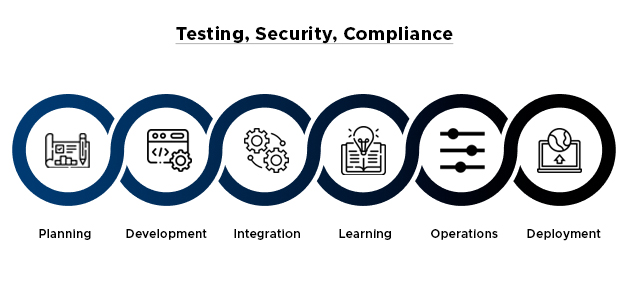-
Blockchain is a disruptive data technology driving the next generation of software development for businesses. Evolving beyond its cryptocurrency roots, blockchain is emerging as a disruptor that can shift assumptions, expenses, and methods of business dynamics. It has become possible due to the trust and transparency that blockchain technology offers.
However, in blockchain app development like cryptocurrency, dApps, NFTs, etc., traditional development methods, where security is secondary, do not apply. Businesses must hire DevOps engineers and opt DevSecOps techniques to ensure the sustainability and security of blockchain and cryptocurrency projects. This article entails more about DevOps for blockchain development.
DevOps for Blockchain App Development
Blockchain solutions benefit from the DevOps methodology as it enables rapid iterations and continuous deployment. It enables cyclical development and implementation while maintaining the integrity of your distributed ledger.
A DevOps team may configure the computing environment, test use cases, and shorten time to market by weeks or months by using purpose-built DevOps tools. It can start developing, configuring, and testing with DevOps tools once a basic architecture of a project is ready.
Explore | Insights into Blockchain Proof-of-Concept (PoC) Development
Blockchain as a Database
A blockchain database's centerpiece is decentralized storage. For the volume of data you need to store, not all blockchains are high-performance and cannot provide efficiency and transparency benefits. It should motivate a DevOps team to manage structured and unstructured data indexing and create an architecture capable of scaling horizontally.
One of the techniques to master is sharding. Distributing data among network clusters and nodes helps to ensure that your blockchain storage can expand.
Some people think sharding is a desperate attempt to save a blockchain's performance. However, distributing data with shards before your database becomes overloaded with data eliminates too heavy loads from the blockchain right away. It can improve performance and scalability rather than waiting until things get out of hand.
Also, Read | Blockchain Development in Retail for Efficiency and Growth
DevOps Tools that Benefit Blockchain Development
Businesses ought to opt for DevOps for blockchain initiatives for the same reasons they do for non-blockchain software development projects. It is because development can happen more quickly, effectively, correctly, and securely with DevOps services.
DevOps is, in some ways, multitasking with a digital transformation. It is not wise to keep a blockchain DevOps team focusing solely on one task, for instance, backups.
It is not moving on to the next step until proper backup configuration. When done the DevOps way, one can perform backups, testing, rollouts, and other tasks concurrently with making simultaneous sustained automation efforts.
You might be building a blockchain-based cryptocurrency or a blockchain as a database. Here are some DevOps tools that can assist you to move straight into the implementation stage:
Suggested Read | Blockchain Development for Advanced Logistics Solutions
Terraform
Terraform, a platform-independent command center, establishes the foundation for DevOps in blockchain development. It automates infrastructure management and includes modules for quick configurations of everything from network loads to storage resources to change implementation. Additionally, Terraform enables you to configure backups in the CI/CD pipelines, including frequency and time of day.
Instances of EC2
EC2 instances are crucial if you're deploying a blockchain network on AWS (Amazon Web Services). You can get the compute resources for your use cases thanks to Amazon's extensive selection of blockchain-friendly EC2 instance types. Due to AWS termination protection and Auto Scaling, you can prepare your blockchain for fault-tolerant growth by setting up storage-optimized instances.
EBS Volumes
You must purchase EC2 instances and EBS volumes in pairs. EBS volumes are excellent for storing data in blockchain projects without having to fear that it might vanish in the future. Although you create them for every instance, they operate independently to guarantee your network data is always available (whether the instance is running or shut down).
Additionally, you can encrypt each storage volume to increase security.
Load Balancer
You need this tool for shredding. A load balancer allows you to send sharded data to storage and optimize data flows across numerous blockchain nodes. Finally, load balancing will enable quicker database searches and increased availability, minimizing the possible effects of a catastrophe or system failure.
Ansible
Ansible is another crucial solution for DevOps for blockchain development activities, such as automation and configuration. It works well with EC2 instances, a load balancer, and other tools when deploying nodes and establishing their connections to storage. You can save time with Ansible by creating commands that teams can repeat and comprehend to automate deployment and continuous delivery.
These tools enable DevOps in blockchain development when used in tandem. It is because they let you manage an infrastructure that your teams can easily maintain, update, restore, and monitor anytime. Of course, making processes easier to automate and improving scalability also matter.
Also, Check | Blockchain Development for Automobile Industry Solutions
DevOps Tools for Scalability and Testing
It would be best if you considered DevSecOps while thinking about blockchain development and DevOps. In a situation where transactions flow back and forth, security experiments are impossible. According to an IBM analysis, the average cost of a security issue such as a data breach is projected to be above $4.3 million. Choose test-driven development (TDD) to avoid paying for something you should have fixed before release.
TDD entails testing a blockchain's security as it is being built, as opposed to after it has been operational. Adopting this method allows you to build a blockchain based on its advantages and disadvantages. Enhancing the former and compensating for the latter to achieve fault tolerance.
Effective Methods of Testing
Security testing in cyclic TDD entails checking all components of a shared ledger and data access rules. Here are some of the more effective methods:
- Use Gremlin and AWS Fault Injection Simulator to conduct chaos tests for controlled blockchain interruptions.
- Keep track of the time your teams spend identifying and fixing security problems.
- Automate security tests for more precise test outcomes and quicker corrective measures.
- Build your blockchain against the flaws revealed by chaos tests to increase its resilience.
You should focus on performance, integration, and unit tests once your blockchain appears to be able to withstand security threats. Both Terraform and Ansible are excellent for writing tests with little coding. In addition to these tools, you may learn how to use Hyperledger Composer to test smart contracts automatically.
You can employ other scaling options in addition to DevOps technologies. To remove some transaction procedures from your blockchain, you can add so-called Layer-2 solutions as an additional layer.
Scaling a blockchain or crypto-based blockchain platform becomes easier with Layer-2 solutions. They can manage resource- and data-intensive processes across it.
Also, Visit | Enterprise Blockchain Development | Nut & Bolts
Best Practices for Software Delivery in Blockchain Development
Testing for Functional and Load Containerization
Since we are unable to recreate the actual production network in our testing environment, integration and performance testing become increasingly difficult. Keep in mind that it is unreliable and outside of our control.
However, we must do our best. It helps to foresee potential network and node configurations and conduct testing across all of these. Modeling different network topologies can benefit greatly from containerization. But the matrix can easily grow too large, making it more difficult to determine the smallest number of acceptable permutations.
As an illustration, the Hyperledger Fabric package includes several docker-compose files for setting up a basic network configuration.
Chaos Testing
Chaos engineering is a method for creating and running unpredictable distributed systems. You may and should unquestionably use it to simulate node failures, network disruptions, and hostile behavior.
Logging
Although we can not influence the network's nodes, we can have access to the logs. The logs frequently become the only source of information about what our application is doing. Consequently, there is an increase in the significance of organized and useful logs for monitoring.
Check It Out | A Walkthrough of Blockchain Development Service Benefits
Testing of Blockchain Apps
The primary goal of DevOps is to promote continuous deployment and continuous delivery. It does so by reorganizing the interaction between the teams responsible for developing and deploying apps. It resembles a node that manages a variety of duties and distributed network pathways.
Continuous testing includes DevOps as a crucial component. It is a process for carrying out automated tests in the pipeline for delivering software for quick feedback on business risks.
A software release candidate frequently carries these hazards. Similarly, real-time authentication is necessary for blockchain because every chain member may instantly access the information related to a block.
Related Post | The Mechanics of Testing Blockchain-based Applications | A How-To Guide
DevOps Process for Blockchain Development

Why Blockchain Development Needs DevOps
The adoption of blockchain solutions must follow the same security management procedures required for open-source component development. It entails integrating the DevOps methodology into the development cycle.
Organizations are under constant pressure to innovate and adhere to strict release timetables. They can stay on schedule without compromising quality by taking the help of our skilled blockchain developers. Our experts can integrate a well-planned DevOps cycle into their blockchain application development.

Our Offices
INDIA
Emaar Digital Greens, Sector 61,
Gurugram, Haryana
122011.
Welldone Tech Park,
Sector 48, Sohna road,
Gurugram, Haryana
122018.














